Jump to Part One – Malmö, Part Two – Copenhagen, or Part Three – My Talks in Lund
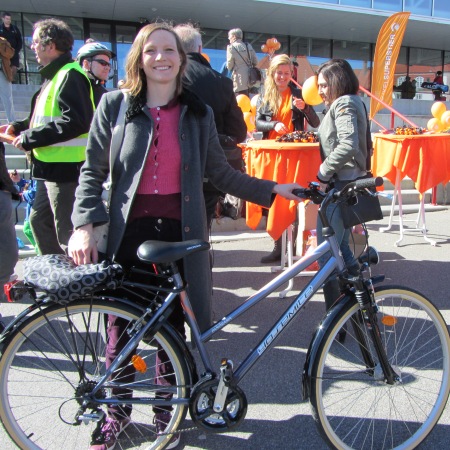 Bearing in mind the unreliability of opinions developed during short visits, here’s a postcard from Øresund. I’ve been giving a seminar series at Lund University, staying in Malmö and visiting Copenhagen. Very much appreciating the Erasmus exchange that has allowed me to do this (and I’m also grateful to Till Koglin at Lund for arranging the series, and my manager Tim for agreeing I can work from Øresund for a fortnight too!)
Bearing in mind the unreliability of opinions developed during short visits, here’s a postcard from Øresund. I’ve been giving a seminar series at Lund University, staying in Malmö and visiting Copenhagen. Very much appreciating the Erasmus exchange that has allowed me to do this (and I’m also grateful to Till Koglin at Lund for arranging the series, and my manager Tim for agreeing I can work from Øresund for a fortnight too!)
Part One
I’m staying in a residential neighbourhood in Malmö south of Triangeln. There’s a lovely square a short ride away that’s full of vegetable stalls during the day (a proper veg market, with lots of shouting and bargaining) and in the evening has people spilling out from the pubs. 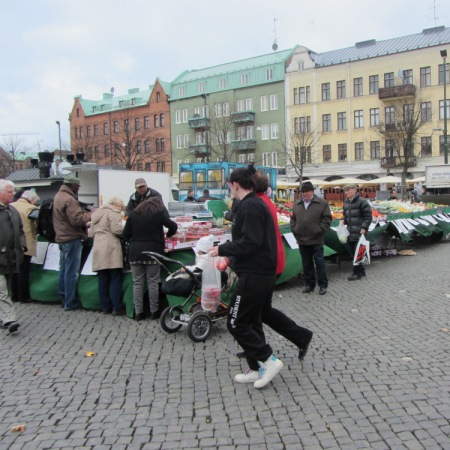 My apartment is on a small estate, and the streets nearby have been effectively traffic calmed.
My apartment is on a small estate, and the streets nearby have been effectively traffic calmed.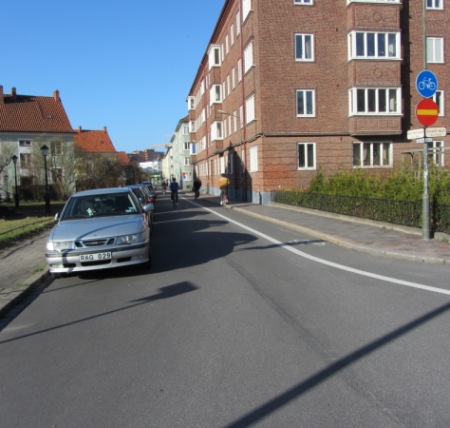 There are plenty of permeable cut-throughs suitable for pedestrians and cyclists. I also saw bicycle contraflows where motor traffic or parking has been restricted in order to facilitate through cycle traffic: like this section of my route to Lund.
There are plenty of permeable cut-throughs suitable for pedestrians and cyclists. I also saw bicycle contraflows where motor traffic or parking has been restricted in order to facilitate through cycle traffic: like this section of my route to Lund.
The bike facilities in Malmö are not the Full Dutch: cycling along Nobelsvagen I suddenly found the bike track disappeared, dumping me out on to a fast multilane road where I had to overtake parked vehicles while cars zoomed past my shoulder. 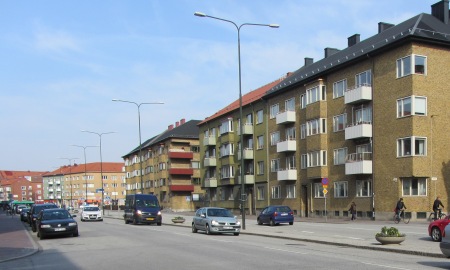 I had to get my head back into HTFU mode swiftly and it wasn’t pleasant. Stopping to catch my breath, I noticed other cyclists riding on the pavement instead, because of the intimidating road and lack of facilities. Now where have we seen this before?
I had to get my head back into HTFU mode swiftly and it wasn’t pleasant. Stopping to catch my breath, I noticed other cyclists riding on the pavement instead, because of the intimidating road and lack of facilities. Now where have we seen this before?
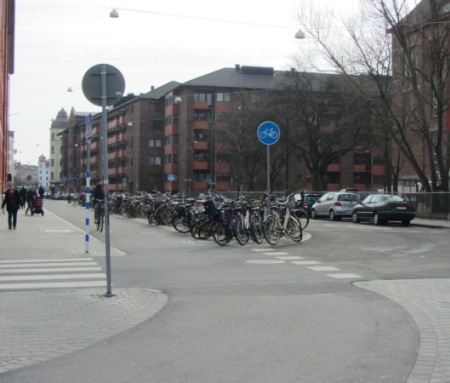
However, overall I’ve really liked Malmö and riding around it (even if the Dutch would, no doubt correctly, criticise the bi-directional paths and the sometimes inadequate junction treatment). Most of the time, I easily found quiet cut throughs, wide segregated paths along busier roads, and pleasant shared or segregated routes through parks. I could pootle through the old city centre streets looking at the buildings, or speed along the wide tracks leading out of town.
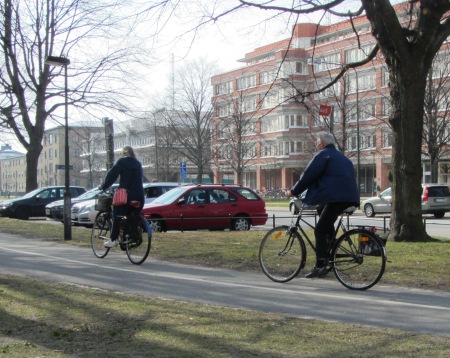 Cyclists also seemed a diverse lot: Malmö has the most ethnically diverse population in Sweden. Riding to the train station this morning I saw mostly older people of varying ethnicities and both genders on their bikes, cycling slowly and sociably on the cycle tracks, which were generally wide enough to overtake people riding two abreast without much difficulty. Cycling had clearly been made a lot more inclusive than we Brits have managed yet: it’s worth remembering that the health benefits for older people from cycling are the largest of all.
Cyclists also seemed a diverse lot: Malmö has the most ethnically diverse population in Sweden. Riding to the train station this morning I saw mostly older people of varying ethnicities and both genders on their bikes, cycling slowly and sociably on the cycle tracks, which were generally wide enough to overtake people riding two abreast without much difficulty. Cycling had clearly been made a lot more inclusive than we Brits have managed yet: it’s worth remembering that the health benefits for older people from cycling are the largest of all.
Part Two: Copenhagen
I’ve had a couple of trips back over the Øresund bridge to Copenhagen. Even given the high price of a rail ticket (plus half fare for the bike!) I can’t stay away. It’s a shame they didn’t build a bike track as well as a rail and motor vehicle route though – it would be a spectacular if windy cycle, allowing some of the people who live in one city and work in another to commute by bike. The link alone is 12km, so it wouldn’t suit everyone, but some would. (And I love the idea that in The Bridge, which I felt was appropriate to bring with me to watch, the guy could have dumped the bodies on the bridge using a Christiania trike…)
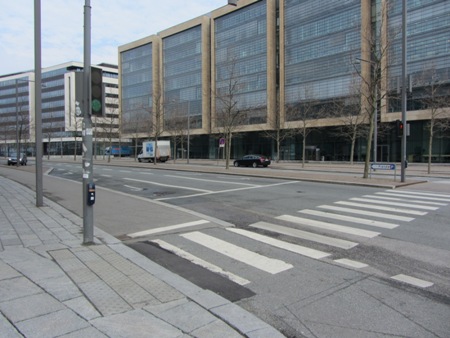 On my first visit I initally stopped at the Ørestad city area, a new town on Amager island where I had a morning meeting with Erik Kjaergaard from Atkins – we swapped notes on cycling policy (and cycling) in Copenhagen and London. Many differences but also some similarities; both cities have cycling targets that need serious effort to be achieved. It was interesting to see the Ørestad area itself – the cycling infrastructure was spacious and comprehensive as you would expect in a new development in Denmark (not in the UK, of course, where I always find it depressing to see how cycling-hostile newer developments tend to be). But it did feel a bit soulless – all the large buildings, the motorway and airport, gave the sense of an international corporate zone, not somewhere I wanted to linger after my meeting.
On my first visit I initally stopped at the Ørestad city area, a new town on Amager island where I had a morning meeting with Erik Kjaergaard from Atkins – we swapped notes on cycling policy (and cycling) in Copenhagen and London. Many differences but also some similarities; both cities have cycling targets that need serious effort to be achieved. It was interesting to see the Ørestad area itself – the cycling infrastructure was spacious and comprehensive as you would expect in a new development in Denmark (not in the UK, of course, where I always find it depressing to see how cycling-hostile newer developments tend to be). But it did feel a bit soulless – all the large buildings, the motorway and airport, gave the sense of an international corporate zone, not somewhere I wanted to linger after my meeting.
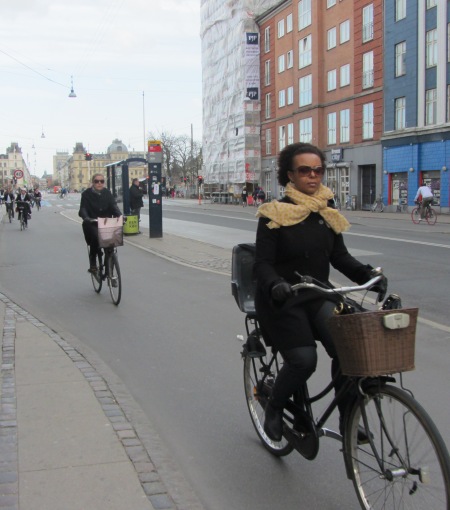
After a visit to the excellent and now free National Museum, where I was impressed by the massive collection of Stone Age artefacts (and amused by the museum’s description of the Anglo-Saxon Chronicle as unfairly stereotyping the Vikings) I rode up to Nørrebrogade. (Judging by my Danish acquaintances’ faces, my attempts to pronounce this word are also quite amusing). Along the way I sighed with envy at the three new cycle and pedestrian bridge Copenhagen’s getting; Copenhageners are no doubt (and rightly) annoyed at the delay in finishing these bridges but for a Londoner, it’s hard not to be jealous given our most recent non-motorised bridge over the Thames, the Millenium Bridge, was designed to exclude cyclists.
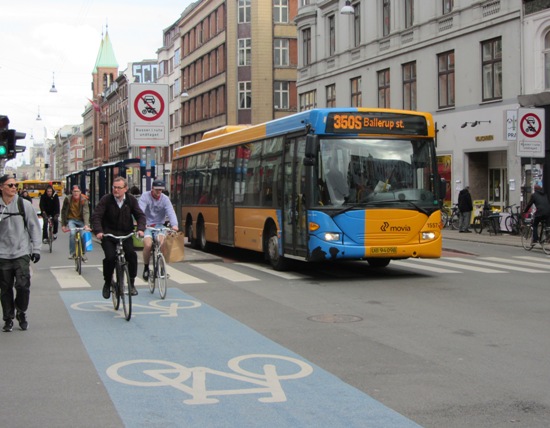 Nørrebrogade remains a great place for getting shots of cyclists looking effortlessly cool. It’s also interesting because after some struggle, private motor vehicle access has been restricted and the cycle tracks widened. There’s a bus gate part way up. The buses are pretty frequent, but the ‘floating bus stops’ (and the bus stops where passengers get on and off from the cycle track) that seem of great concern in the UK don’t seem a major issue here. Cyclists do slow down and stop; I guess it’s a trade off for having wide, well surfaced cycle tracks with green wave cycle priority – you have a generally safe but speedy (if you want!) environment, but you have to give way to pedestrians at conflict points. Sounds like a good trade off to me and an excellent trade off for all the people who cycle in Copenhagen but won’t in London. I also saw a number of mobility scooters on these cycle tracks, providing enhanced mobility for people who otherwise would have been slow on the pavement or threatened on the road.
Nørrebrogade remains a great place for getting shots of cyclists looking effortlessly cool. It’s also interesting because after some struggle, private motor vehicle access has been restricted and the cycle tracks widened. There’s a bus gate part way up. The buses are pretty frequent, but the ‘floating bus stops’ (and the bus stops where passengers get on and off from the cycle track) that seem of great concern in the UK don’t seem a major issue here. Cyclists do slow down and stop; I guess it’s a trade off for having wide, well surfaced cycle tracks with green wave cycle priority – you have a generally safe but speedy (if you want!) environment, but you have to give way to pedestrians at conflict points. Sounds like a good trade off to me and an excellent trade off for all the people who cycle in Copenhagen but won’t in London. I also saw a number of mobility scooters on these cycle tracks, providing enhanced mobility for people who otherwise would have been slow on the pavement or threatened on the road.
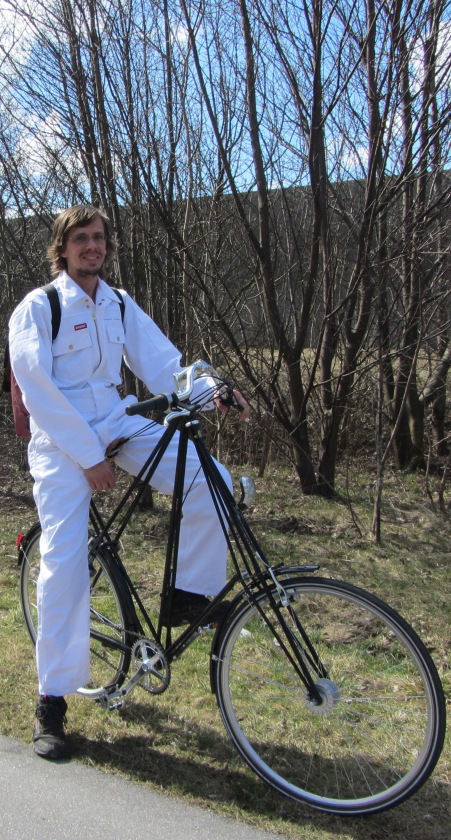 Yesterday, I attended the launch of the second Cycle Superhighway in Copenhagen: meeting at Bellahøj, we rode up to Farum, along what the municipality hopes will become an increasingly popular commuter route. Positives first: of course, compared to Cycle Superhighway 2 in London, this looks great. It’s both direct and segregated from motor traffic; the surfaces are excellent and allow super speedy riding for those that can (which is very welcome – the whole route is 22km), the tracks are reasonably wide, and there’s clear priority over side roads. It’s good to see longer commutes being targeted in this way.
Yesterday, I attended the launch of the second Cycle Superhighway in Copenhagen: meeting at Bellahøj, we rode up to Farum, along what the municipality hopes will become an increasingly popular commuter route. Positives first: of course, compared to Cycle Superhighway 2 in London, this looks great. It’s both direct and segregated from motor traffic; the surfaces are excellent and allow super speedy riding for those that can (which is very welcome – the whole route is 22km), the tracks are reasonably wide, and there’s clear priority over side roads. It’s good to see longer commutes being targeted in this way.
The ride was definitely an enthusiasts’ gathering – there were some fantastic Velomobiles, recumbents and other joys for the bike nerd, as well as enough Lycra for me to feel I was in the UK at times (if I looked at the riders, and not the route). I hoped to get more pictures of people riding, but, for a large part of the journey I was near the back. The ride was fast! Even the smallish children managed to keep up a good speed. Riders were regularly overtaken by even faster cyclists, in full-on matching kit, ringing their bells furiously – other people told me the route is popular among training riders. 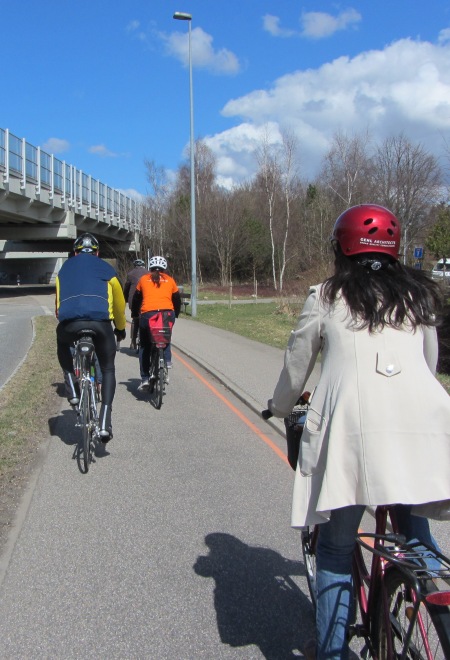
Which I guess brings me to my critical comments. Given there were so many riding groups, of various speeds, then even though the tracks were wide compared to UK standards, I think they could have been wider. As I set off chatting to Chunli Zhao or Thomas (who I’ve met through the Bikeability project), we often had to stop speaking to let faster riders past. And while most of the route felt very safe, there were a couple of big junctions on the outskirts of Copenhagen that felt a bit iffy (one person I chatted to said there had been a number of collisions there and he’d hoped it would have been improved).
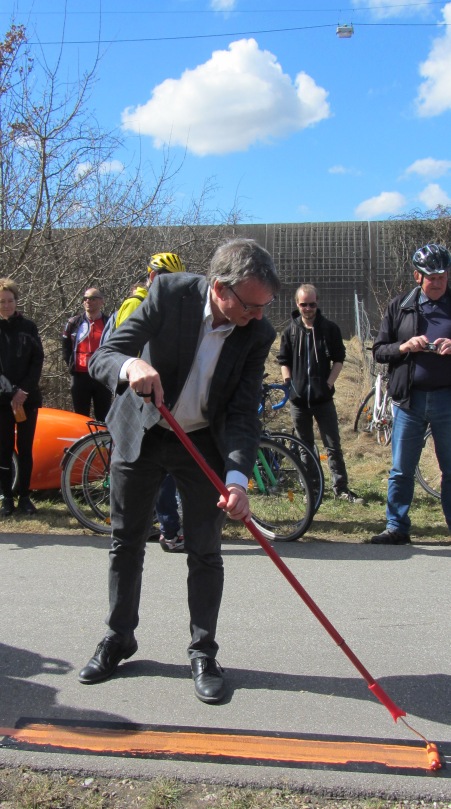 And slightly (but only slightly) facetiously, if something’s ‘super’, why not top the Dutch and put on all the bells and whistles. If people are commuting 22km each way, why not have stalls part way along supplying free ice cream in Summer, and free hot drinks in Winter? Jobs for Denmark’s unemployed youth, and commuters really feel like they are valued 🙂
And slightly (but only slightly) facetiously, if something’s ‘super’, why not top the Dutch and put on all the bells and whistles. If people are commuting 22km each way, why not have stalls part way along supplying free ice cream in Summer, and free hot drinks in Winter? Jobs for Denmark’s unemployed youth, and commuters really feel like they are valued 🙂
More fundamentally, I was told that the route had changed relatively little; there is now a line of orange paint along it, but much of the infrastructure pre-dated the launch – people I spoke to could only point to the floor lighting on the last section of the route, and some public bicycle pumps along the way, as definitely new. So mainly, it seems, it’s about re-branding, which can be valuable – if you build it and don’t tell them, they might not come – but not about large scale new infrastructure. A couple of people I talked to were worried that this kind of project is being prioritised ahead of putting in place new cycle tracks in the city where they’re still missing (which is more controversial, involving taking away space for moving or parked cars). Commuter routes of this quality in the UK would be fantastic. But is Copenhagen making the step-change that’ll be needed to reach it’s 50% target?
Part Three: My Talks in Lund
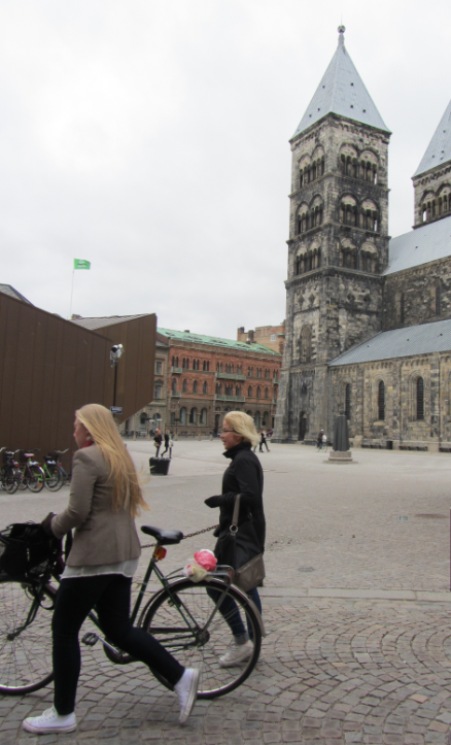
 On Tuesday and Friday this week I gave talks at Lund University. Lund is a beautiful university town, a bit under 20 km from Malmö. Tuesday’s talk was called ‘Is Cycling Normal?’ and was basically me talking about the sociology of cycling, particularly with respect to some of the findings of the Cycling Cultures project. Friday’s talk focused on cycling advocacy in London, and was based on three articles I’ve written and more recent observations. It was great to discuss both my research and the London and UK experience with Swedish and Danish people; interesting too that there seemed to be some potential similarities between experiences in Stockholm (where cycling rates have traditionally been relatively low for Sweden) and London.
On Tuesday and Friday this week I gave talks at Lund University. Lund is a beautiful university town, a bit under 20 km from Malmö. Tuesday’s talk was called ‘Is Cycling Normal?’ and was basically me talking about the sociology of cycling, particularly with respect to some of the findings of the Cycling Cultures project. Friday’s talk focused on cycling advocacy in London, and was based on three articles I’ve written and more recent observations. It was great to discuss both my research and the London and UK experience with Swedish and Danish people; interesting too that there seemed to be some potential similarities between experiences in Stockholm (where cycling rates have traditionally been relatively low for Sweden) and London.
The talks:
You can look at the slides from ‘Is Cycling Normal’ and listen to the audio (MP3, very large file, c.90MB).
You can look at the slides from ‘New Cycling Advocacy’ and listen to the audio (M4A, very large file, c.90 MB).

